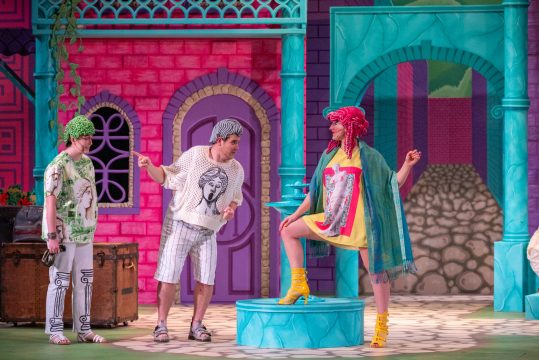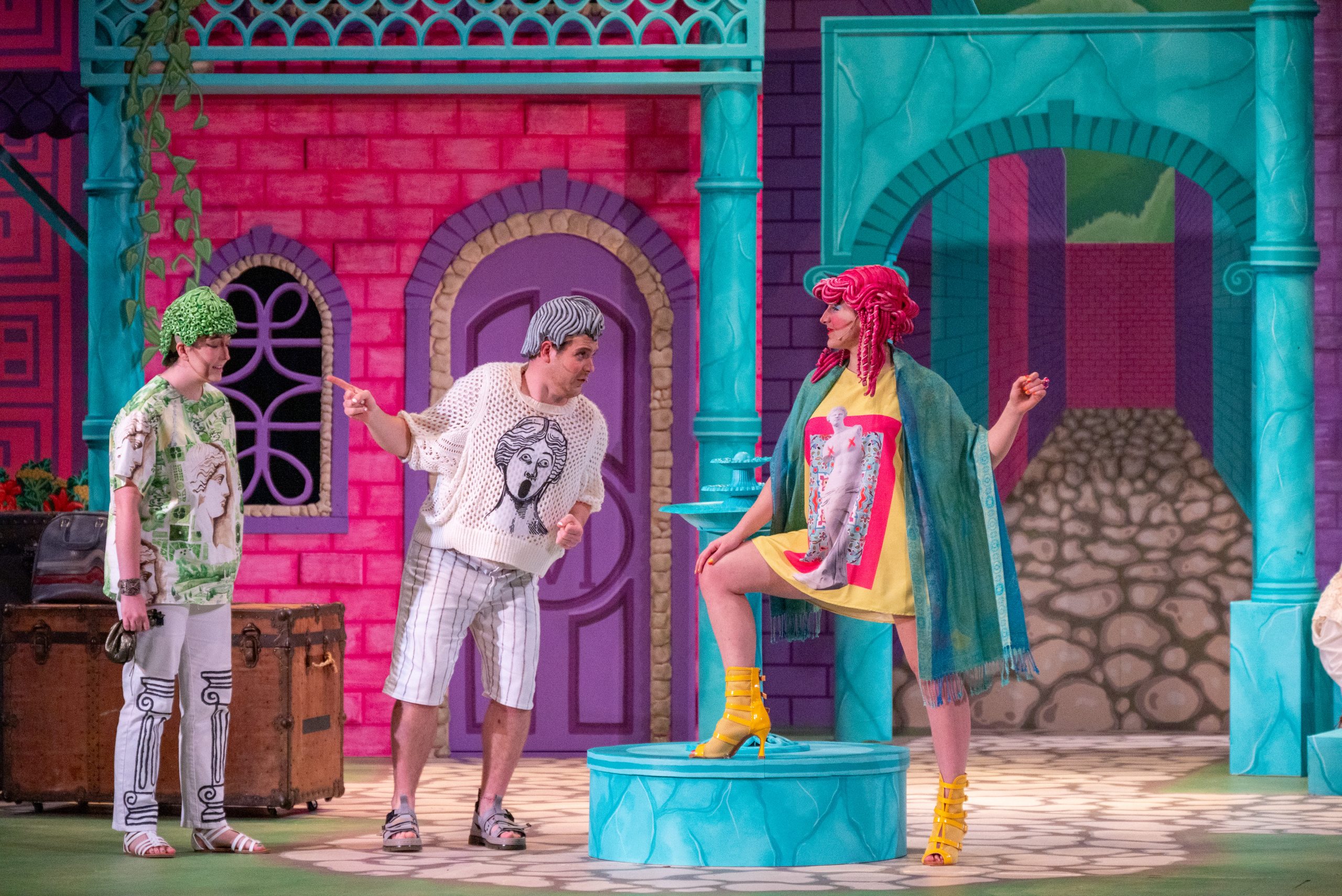For many, the phrase “ancient Roman theater” suggests a boring, dated and colorless performance. The Lawrence University Theatre Arts Department’s performances of “Menaechmi” by Plautus from Oct. 26 through Oct. 29 were none of these things. In fact, they actively achieved a contemporary presence in matters of excitement, relevance and, especially, color.
As the lights dim, a cacophonous ensemble of pre-recorded kazoos began. On stage we see sophomore Anya Etringer and first years Josephine Ann Matchette and Taryn Mangin, who give us a blunt run down of the synopsis. Although the program listed them as merely “Backup Singers,” they impressively pivoted between narration, singing, dance and comedic roles throughout the performance.
The story centers around Menaechmus II searching for his long-lost identical twin of the same name. When Menaechmus II arrives by sea to find his brother Menaechmus I in Epidamnus, their identical appearances stir up confusion throughout the city.
This general trope may be familiar: identity confusion and long-lost twins remained a hallmark of Western comedies into the Renaissance. Indeed, Menaechmi is known to have been inspiration for William Shakespeare’s “The Comedy of Errors.”
The actors face split fortunes with roles like these. On one hand, Plautus’ characters have minimal outward complexity, so convincing performances need not be Oscar-worthy. Yet the inclusion of many stock characters — the comedic servant, the nagging wife and the charlatan doctor — makes meaningful characterization difficult.
Menaechmus I was portrayed thoughtfully by first-year Ashlyn Garrity, whose performance paired clever comedic timing with audience interaction. Senior Hannah Amell played Menaechmus II and effectively delivered an elaborate range of emotions customized for each scene.
Both twins are accompanied by their clamorous companions who offer comic relief. Played by senior Logan Madson, the parasite Peniculus is motivated only by food, at one point frustrated that a meeting interrupted his lunch. Madson brought genuine energy to his scenes and convinced the audience of his not-so-terrible plight.

Alec Welhouse ‘23’s performance of the enslaved person Messenio had extensive characterization via a hunchback and voice-crack filled speech. Other supporting roles include senior Madeline Guest’s convincing performance as the prostitute Erotium; junior August Hendrix’s touching take as Cylindrus; the appropriately domineering Matrona from senior Ella Rose Schaefer; and senior Charles Brailovsky’s comical doctor performance.
The second act begins redundantly, as it features the same identity confusions. Thankfully, a new character enters: first-year Ann Vincent as Senex, whose strong stage presence galvanized the momentum. Senex’s scenes began with his perspective as an outsider, ridiculing the situation at hand.
Spontaneous moments of comedy were ever present. Amell’s declaration that “the Gods don’t just love me—they’re aiding and abetting me” drew laughter, as did Madson’s remark that “nothing cheers the soul like the prospect of leftovers.”
A parodied stage fight between numerous characters was particularly memorable. During this scene, absurd cartoon sounds coincided with punches, as did literal comic book-derived signs with “Wham” and “Bam” held up by the Backup Singers.
Incidental music returns frequently throughout the play with lively and flavorful music compositions by Josh Schmidt. Although the kazoos returned throughout, often in pop song arrangements, there was a substantial supply of pre-recorded vocals.
Although Menaechmi is not a musical, the production found ways to utilize Lawrence Conservatory’s hefty supply of singers. Schmidt held vocal recording sessions, in which the three backup singers were joined by junior Grace Hitchens, senior Casey Joan Kollman, sophomore Ruby March-Tormé and sophomore Dalena Williamson.
“[The songs] added intrigue… they were tools to embrace modernity,” said Hitchens. Indeed, the songs emphasized the play’s comical circumstances more so than its ancient origin. The strength of each lay in its dry bluntness; an early number with the repeated chorus, “So nasty, so stupid, so bitchy, just plain nuts,” was met with enthusiastic laughs.
The play — translated in 2005 — is generous with its modern vocabulary in dialogue, too. Included are “audacity,” “human-garbage” and “screw you,” as well as “bitch,” “bitching” and “bitches.”
The costumes of this production are truly exceptional, thanks to the work of Instructor of Theatre Arts and Costume Shop Supervisor Karin Simonson Kopischke and assistant costume designer, sophomore Mercury Thornton. As signifiers of identity, the costuming distinction between the two identical twins — separately in blue and green — is particularly helpful.
Although the vibrant clothing also assists in character recognizability, it is remarkable in its own right. Each character’s costume is primarily a single color, which must be a difficult hurdle for costuming. But no outfit looks forced, and none looks identical either.
Neon colors dominate the set, featuring prominent washes of pink and purple, alongside light blue and green. The set was designed by Hendrix and Welhouse, and follows the play’s traditional, intended setting, a city street with the houses of Menaechmus I and Erotium. Although this alignment with tradition could be considered lackluster, the generous Fauvist coloring amends this.
It is no secret that the production’s aesthetic was designed with the recent Barbie movie in mind. This influence is readily apparent: both effectively reconsidered older topics in a contemporary lens. The neon colors are also shared between both productions, as is comedy, entertainment and excellence.

